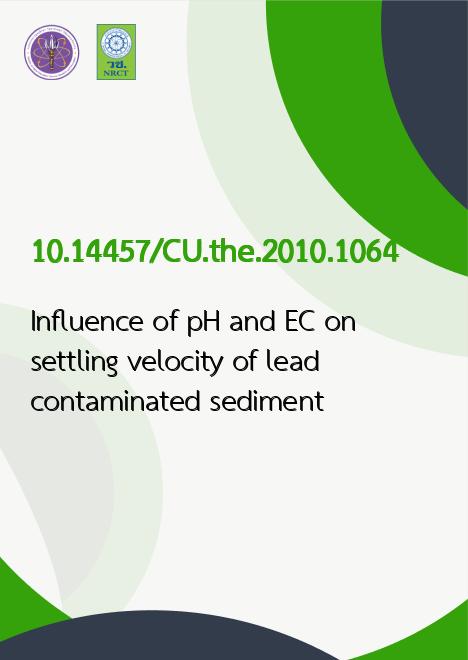
|
Influence of pH and EC on settling velocity of lead contaminated sediment |
|---|---|
| รหัสดีโอไอ | |
| Title | Influence of pH and EC on settling velocity of lead contaminated sediment |
| Creator | Ataya Jongwisuttisun |
| Contributor | Thidarat Bunsri |
| Publisher | Chulalongkorn University |
| Publication Year | 2553 |
| Keyword | Contaminated sediments -- Purification, Sedimentation analysis, Lead -- Separation, Hydrogen-ion concentration, Electric conductivity |
| Abstract | The influence of pH and electrical conductivity on settling velocity and releasing of lead from sediments were technically simulated in this study. The series of settling column with an inner diameter of 47 mm and height of 300 mm were fabricated. The utilised sediment was contaminated with lead at the concentration of 20,250 mg/kg and sand was predominantly composition. The sediment slurry was synthesised with a concentration of 3% (w/w). The prepared sediment slurries was governed by soaking sediments into deionised water, 3.6% (w/w) HCl, 1.2%NaOH (w/w), 1%NaCl (w/w) and 2%NaCl (w/w) solutions. The settling velocity was predicted by Stokes and Dietrich law. The Corey shape and complicating factors were inserted to modified Stokes and Dietrich law. The results showed that the settling velocity of sediment was highly depended on the particle size of sediment. The electrical conductivity and pH could affect the reactions between sediments and ions in the solution. The particles suspended in highly electrical conductivity solution could be dissolved and they accumulated into the solution. Under natural condition, the small particle could be settled slower than large particle. The particles in acid condition were eroded and their size was reduced, resulting in highly dispersion. The particles were bound to hydroxide under alkaline solution. The size and density of particles were increased, conducting high the settling velocity. The large particles with saline solution could be settled down slower that the small ones, dealing with the upwards electromotive force. The free Pb could release from suspended particles and bottom sediment. The fine particles were accumulated near the surface, the Pb ions were highly presented at the same elevation. The fine particles were the source of Pb. If the particles could be settled down and the Pb could be stabilised, the migration of Pb was reduced. The alkaline condition could reduce the movement of sediments and Pb bound sediments. The change of pH and EC could influence the settlement and release of Pb from the contaminated sediments. |
| URL Website | cuir.car.chula.ac.th |